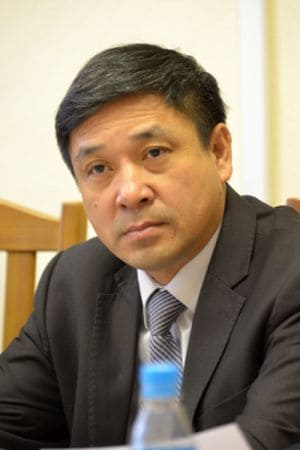Sep 4, 2019 | Austria, Environment, Risk and resilience, Women in Science
By Marlene Palka, research assistant in the IIASA Risk and Resilience Program
Marlene Palka discusses the work done by the IIASA FARM project, which has been investigating drought risk management in Austria for the past three years.
Future climate projections forecast an increase in both the frequency and severity of droughts, with the agricultural sector in particular being vulnerable to such extreme weather events. In contrast to most other climatic extremes, droughts can hit larger regions and often for extended periods – up to several months or even years. Like many other countries, Austria has been and is expected to be increasingly affected, making it necessary to devise a management strategy to mitigate drought damages and tackle related problems. The FARM project – a three year project financed by the Austrian Climate Research Program and run by the IIASA Risk and Resilience and Ecosystems Services and Management programs – kicked off in 2017 and has been investigating agricultural drought risk management both in a broad European context, and more specifically in Austria.

Young sunflowers on dry field © Werner Münzker | Dreamstime.com
Austria represents a good case study for agricultural drought risk management. Despite the agricultural sector’s rather small contribution to the country’s economic performance, it still has value and represents an important part of the country’s historical and cultural tradition. Around 80% of Austria’s total land area is used for agricultural and forestry activities. Equally important is its contribution to the preservation of landscapes, which is invaluable for many other sectors including tourism.
Globally, agricultural insurance is a widely used risk management instrument that is often heavily subsidized. Apart from the fact that the concept is increasingly being supported by European policymakers – the intention being that insurance should play a more prominent role in managing agricultural production risk – more and more voices from other sectors are calling for holistic management approaches in agriculture with the overall aim of increasing the resilience of the system.
There is a well-established mutual agricultural insurance company in Austria, which has high insurance penetration rates of up to 75% for arable land, and comparably high subsidies of up to 55% of insurance premiums. It is also encouraging to note that recent policy decisions support the timeliness of drought risk: in 2013, the Austrian government paid EUR 36 million in drought compensation to grassland farmers and in 2016, premium subsidies of 50% were expanded to other insurance products, including drought, while ad-hoc compensation due to drought was officially eliminated. In 2018, the subsidy rate was further increased to 55%. In light of these prospects, we investigated the management option space of the Austrian agricultural sector as part of the FARM project.
The 2018 Organisation for Economic Co-operation and Development (OECD) report on monitoring and evaluation of agricultural policies claims that efficient (drought) risk management in agriculture must consider the interactions and trade-offs between different on-farm measures, activities of the private sector, and government policies. The report further argues that holistic approaches on all management levels will be vital to the success of any agricultural management strategy.
In the course of our work, we found that agricultural drought risk management in Austria lacks decision making across levels. Although there is a range of drought management measures available at different levels, cooperation that includes farms, public and private businesses, and policy institutions is often missing. In addition, measures to primarily and exclusively deal with drought, such as insurance and irrigation, are not only limited, but (as we found) are also less frequently implemented.
As far as insurance is concerned, products are still being developed, and penetration rates are currently low. Drought risk is also highly uncertain, making it almost impossible to offer extensive drought insurance products. Irrigation is perceived as the most obvious drought management measure among non-agronomists. Simply increasing irrigation to deal with the consequences of drought could however lead to increased water demand at times when water is already in short supply, while also incurring tremendous financial and labor costs and additional stress to farmers. With that said, a large number of agricultural practices may also holistically prevent, cope with, or mitigate droughts. For example, reduced soil management practices are low in operating costs and prevent surface run-off, while simultaneously maintaining a soil structure that facilitates increased water holding capacity. Market futures might also stabilize farm income and therefore allow for future planning such as the purchase of irrigation equipment.
A workshop we held with experts from the Austrian agricultural sector further highlighted this gap. Thinking (not even yet acting) beyond the personal field of action was rare. The results of a survey we conducted showed that farmers were experiencing feelings of helplessness regarding their ability to manage the negative effects of droughts and other climatic extremes despite the implementation of a broad range of management solutions. One way to explain this could be a lack of cooperation across different management levels, meaning that existing efforts – although elaborate and well-proven – potentially reach their limit of effectiveness sooner rather than later.
Due to the more complex effects of any indirect/holistic drought management measure, we need tailored policies that take potential interdependencies and trade-offs into account. With evidence from the FARM project, my colleagues and I would like to emphasize an integrated risk management approach, not only at farm level but also in all relevant agencies of the agricultural sector in an economy. This will help to secure future production and minimize the need for additional public financial resources. Our findings not only contribute to ongoing high-level discussions, but also underpin the resulting claim for more holistic (drought) risk management with bottom-up data from our stakeholder work.
Note: This article gives the views of the author, and not the position of the Nexus blog, nor of the International Institute for Applied Systems Analysis.
Aug 27, 2019 | Climate Change, Environment, Risk and resilience, Young Scientists
By Luiza Toledo, IIASA Science Communication Fellow 2019
2019 YSSP participant Regina Buono investigates how the law can support or impede the use of nature-based solutions and help facilitate adaptation to climate change.
Recognizing the need for a systemic change is the first step to overcoming environmental challenges like climate change. In theory, governance systems can be designed and arranged to facilitate and embrace adaptation to climate change. Developing a legal framework that supports such an adaptation is, however, a big challenge. Learning how to manage the environmental crisis we currently find ourselves in while still being able to grow economically further complicates matters. According to Regina Buono, a participant in this year’s IIASA Young Scientist Summer Program (YSSP), nature-based solutions could be an alternative option that offers a multitude of benefits in terms of how this dual goal of economic growth and sustainability can be achieved. Buono’s research will contribute to IIASA as a partner in the EU Horizon 2020 project, PHUSICOS, which is demonstrating how nature-based solutions can reduce the risk of extreme weather events in rural mountain landscapes.

Outdoor green living wall, vertical garden on modern office building | © Josefkubes | Dreamstime.com
Nature-based solutions are actions to protect, manage, or restore natural ecosystems that address societal challenges, such as water security, pollution, or natural disasters – sometimes simultaneously. These solutions take advantage of the system processes found in nature – such as the water regulation function of wetlands, the allowance of natural space in floodplains to buffer flooding impacts, water storage in recharged aquifers, or carbon storage in prairies – to tackle environmental problems. This concept is now widely used to reframe policy debates on biodiversity conservation, climate change adaptation and mitigation strategies, urban resilience, as well as the sustainable use of natural resources.
As part of her research, Buono is exploring how the law can support or impede the use of nature-based solutions and considering how we can make legal systems more adaptive so they can help facilitate societal adaptation to a more uncertain world under ongoing and future climate change.
“My research is about using the law as a tool that works for us, rather than one that, because of its historic interest in stability, gets in the way,” she says.

Regina Buono, YSSP participant. | © Buono
Buono started her career as a lawyer based in the US. In her first job she was assigned to work with water issues and according to her, it was “love at first sight”. Following that first assignment, she continued to work on finding market-based solutions for issues related to endangered species. She decided to pursue a PhD in public policy in 2016, and soon after was asked to join the external advisory board to the Nature Insurance Value: Assessment and Demonstration (NAIAD) project in Europe. While attending the first meeting, she realized that there were no lawyers or legal scholars among the project researchers. As a lawyer, she could see that there was a gap in understanding how law and regulations would impact the uptake, development, and proliferation of nature-based solutions.
Working with NAIAD, she developed her PhD dissertation to address this gap and advance understanding around the role of the law in nature-based solutions, both in terms of governance in implementation and practice and the potential for governance innovation that better supports and promotes future adaptation.
“My YSSP project here at IIASA focuses on the city of Valladolid, Spain, and examines the legal context around the implementation of a collection of nature-based solution projects. I am trying to draw insights from these that could perhaps also be applied to other cases,” she explains.
Buono is doing a critical qualitative study that integrates analyses of interviews and policy documents using NVivo, a qualitative data analysis computer software package specifically designed to work with very rich text-based and/or multimedia information, together with legal analysis. She says that there is still a lot of work to be done to adapt to climate change and an interdisciplinary cross-sector effort will be necessary.
The preliminary results from her YSSP research point to a number of constraints and facilitating factors related to law and regulation. She says that the lack of explicit legal authorization for nature-based solutions that she identified in her study, strict water quality regulations, and bureaucratic hurdles could be some of the factors that constrain the implementation of nature-based solutions. However, flexibility in the law and a polycentric governance structure was identified as facilitating factors that encourage local entities to opt for nature-based solutions.
Buono hopes that her research will help decision makers to assess and address legal components that guide, structure, or impede the use of nature-based solutions, and to consider how the law could be evolved to create a more enabling environment for more adaptive governance arrangements that would better support nature-based solutions.
“Our policies and infrastructure are going to have to change to be able to deal with the impacts that we are already experiencing. Nature-based solutions and a shift toward adaptive governance could help us navigate more gracefully in these important transitions,” she concludes.
Note: This article gives the views of the author, and not the position of the Nexus blog, nor of the International Institute for Applied Systems Analysis.
Jul 11, 2019 | IIASA Network, USA, Women in Science
Rachel Potter, IIASA communications officer, interviews retired NASA Astronaut and Principal of AstroPlanetview LLC, Sandra H Magnus on insights about our world she has gained from her time living on the International Space Station.

©NASA Photo / Houston Chronicle, Smiley N. Pool
Q: Can you tell us a bit about your specific areas of research as a scientist?
A: My PhD was on a new material system being investigated for thermionic cathodes, which are used as electron sources for satellite communication systems. My research was an effort to look at the system methodically and from a science viewpoint to understand physically what was going on in order to inform the design of more robust devices. If you can operate the cathode at a lower temperature, that means a longer life for it, which is a good thing for satellites! Post-PhD I was however admitted to the Astronaut Office and that, quite frankly, pretty much put an end to my career as a researcher, or at least as a principal investigator (PI). The work I did on the International Space Station was at the direction of other PIs who had proposed, and been granted, experiments in space.
Q: Your career has spanned a wide range of settings from the NASA Astronaut Corps to your current role as Principal of AstroPlanetview LLC – what is the common thread or focus that has run through your work?
A: Following my curiosity and looking for challenges. I always want to be challenged and feel that I am learning new things. If I feel that I have become stagnant, I start looking for how to change that situation.
Q: What have been the personal highlights of your career?
A: Clearly flying in space! I feel very fortunate, however, to have been in the Astronaut Office during the era of the space station. I enjoyed very much working in a collaborative, multicultural, international environment where we had a big team of people from around the world working on something that benefits the planet.
Q: What are the greatest lessons you have learned from seeing the Earth from space?
A: I was so excited to FINALLY be going into space after hoping to do just that for over 20 years. The Earth is our spaceship – a closed system in which everything on the planet affects, and is connected to everything else on the planet. An action somewhere means a reaction somewhere else, even if it is not always first order (and usually it is not). Also, the planet looks incredibly beautiful and very fragile – we have to take care of it!

© NASA STS-126 Shuttle Mission full crew photo (5 March 2008), Sandra H Magnus far left.
Q: What do you see as key to solving the complex problems the Earth faces in terms of sustainability?
A: Having the will to do it as a community. If you have the will, commitment and a clear, agreed-to, articulation of the common goal, we can pretty much accomplish anything we want to.
Q: How do you see IIASA being able to build bridges between countries across political divides?
A: Well, when we want to solve problems, it really is all about relationships at the end of the day. It is easy to demonize or keep your distance from abstract ideas or the ubiquitous “They” but when you meet people, understand them as individuals and the context of their backgrounds that lead them to have different views and approaches to life and solving problems, it is much easier to visualize how you can work together to tackle issues. The relationships are the bridges.
Q: What advice would you give to young women researchers wanting to make it into Aeronautics?
A: To young women (and young men, too, really) I would say, “If you have a dream to go do something, then you owe it to yourself to go for it and try it!” Never let anyone else define who you are or tell you what you can or cannot do – believe in yourself and give it a try. Maybe you will make it, maybe you will not, but it will be on your own terms, with you pushing yourself and regardless of the outcome you will have a deeper understanding of yourself, and that is always a good thing.
Sandra H Magnus visited IIASA on 21 June 2019 in cooperation with the US Embassy Vienna, to give a lecture entitled “Perspectives from Space” to IIASA staff and this year’s participants of the IIASA Young Scientists Summer Program. IIASA has a worldwide network of collaborators who contribute to research by collecting, processing, and evaluating local and regional data that are integrated into IIASA models. The institute has 819 research partner institutions in member countries and works with research funders, academic institutions, policymakers, and individual researchers in national member organizations.
Notes:
This article gives the views of the authors, and not the position of the Nexus blog, nor of the International Institute for Applied Systems Analysis.
May 29, 2019 | Science and Policy, Vietnam
Tran Thi Vo-Quyen, IIASA guest research scholar from the Vietnam Academy of Science and Technology (VAST), talks to Professor Dr. Ninh Khac Ban, Director General of the International Cooperation Department at VAST and IIASA council member for Vietnam, about achievements and challenges that Vietnam has faced in the last 5 years, and how IIASA research will help Vietnam and VAST in the future.

Professor Dr. Ninh Khac Ban, Director General of the International Cooperation Department at VAST and IIASA council member for Vietnam
What have been the highlights of Vietnam-IIASA membership until now?
In 2017, IIASA and VAST researchers started working on a joint project to support air pollution management in the Hanoi region which ultimately led to the successful development of the IIASA Greenhouse Gas – Air Pollution Interactions and Synergies (GAINS) model for the Hanoi region. The success of the project will contribute to a system for forecasting the changing trend of air pollution and will help local policy makers develop cost effective policy and management plans for improving air quality, in particular, in Hanoi and more widely in Vietnam.
IIASA capacity building programs have also been successful for Vietnam, with a participant of the 2017 Young Scientists Summer Program (YSSP) becoming a key coordinator of the GAINS project. VAST has also benefited from two members of its International Cooperation Department visiting the IIASA External Relations Department for a period of 3 months in 2018 and 2019, to learn about how IIASA deals with its National Member Organizations (NMOs) and to assist IIASA in developing its activities with Vietnam.
What do you think will be the key scientific challenges to face Vietnam in the next few years? And how do you envision IIASA helping Vietnam to tackle these?
In the global context Vietnam is facing many challenges relating to climate change, energy issues and environmental pollution, which will continue in the coming years. IIASA can help key members of Vietnam’s scientific community to build specific scenarios, access in-depth knowledge and obtain global data that will help them advise Vietnamese government officials on how best they can overcome the negative impact of these issues.
As Director General of the International Cooperation Department, can you explain your role in VAST and as representative to IIASA in a little more detail?
In leading the International Cooperation Department at VAST, I coordinate all collaborative science and technology activities between VAST and more than 50 international partner institutions that collaborate with VAST.
As the IIASA council representative for Vietnam, I participate in the biannual meeting for the IIASA council, I was also a member of the recent task force developed to implement the recommendations of a recent independent review of the institute. I was involved in consulting on the future strategies, organizational structure, NMO value proposition and need to improve the management system of IIASA.
In Vietnam, I advised on the establishment of a Vietnam network for joining IIASA and I implement IIASA-Vietnam activities, coordinating with other IIASA NMOs to ensure Vietnam is well represented in their countries.
You mentioned the development of the Vietnam-IIASA GAINS Model. Can you explain why this was so important to Vietnam and how it is helping to improve air quality and shape Vietnamese policy around air pollution?
Air pollution levels in Vietnam in the last years has had an adverse effect on public health and has caused significant environmental degradation, including greenhouse gas (GHG) emissions, undermining the potential for sustainable socioeconomic development of the country and impacting the poor. It was important for Vietnam to use IIASA researchers’ expertise and models to help them improve the current situation, and to help Vietnam in developing the scientific infrastructure for a long-lasting science-policy interface for air quality management.
The project is helping Vietnamese researchers in a number of ways, including helping us to develop a multi-disciplinary research community in Vietnam on integrated air quality management, and in providing local decision makers with the capacity to develop cost-effective management plans for the Hanoi metropolitan area and surrounding regions and, in the longer-term, the whole of Vietnam.
About VAST and Ninh Khac Ban
VAST was established in 1975 by the Vietnamese government to carry out basic research in natural sciences and to provide objective grounds for science and technology management, for shaping policies, strategies and plans for socio-economic development in Vietnam. Ninh Khac Ban obtained his PhD in Biology from VAST’s Institute of Ecology and Biological Resources in 2001. He has managed several large research projects as a principal advisor, including several multinational joint research projects. His successful academic career has led to the publication of more than 34 international articles with a high ranking, and more than 60 national articles, and 2 registered patents. He has supervised 5 master’s and 9 PhD level students successfully to graduation and has contributed to pedagogical texts for postgraduate training in his field of expertise.
Notes:
More information on IIASA and Vietnam collaborations. This article gives the views of the authors, and not the position of the Nexus blog, nor of the International Institute for Applied Systems Analysis.
May 17, 2019 | Alumni, Risk and resilience, Young Scientists
By Tobias Sieg, IIASA Young Scientists Summer Program alumnus
IIASA Young Scientists Summer Program alumnus Tobias Sieg explains how risk assessments considering uncertainties can substantially contribute to better risk management and consequently to the prevention of economic impacts.

© Topdeq | Dreamstime.com
According to the World Economic Forum’s Global Risk Landscape 2018, extreme weather events and natural disasters are ranked among the top three global risks. For many regions, hydro-meteorological risks – in other words, weather or water related events like cyclones or floods that pose a threat to populations or the environment – constitute the biggest threat. This calls for a comprehensive scientific risk assessment with a particular focus on large associated uncertainties.
Assessing the risk of hydro-meteorological hazards without considering these uncertainties, is like entering a pitch-dark labyrinth. You have no idea where you are and where you will end up. If you enter with a flashlight, you might still not immediately know exactly where you will end up, but at least you can assess your possibilities for finding a way out.
We should all care to see those possibilities and to identify uncertainties, since the consequences of hydro-meteorological hazards can have severe impacts on socioeconomic systems, and global- and climate change could favor the occurrence of floods. An increase in extreme weather events, such as heavy precipitation can be expected along with an increasingly warmer climate. In combination with uncontrolled socioeconomic development, these extreme weather events could potentially trigger more intense hazardous flood events in the future. Appropriate management of their consequences is therefore required, starting from today, while pro-actively thinking about the future. To that end, risk management policy and practice need reliable estimates of direct and indirect economic impacts.
The reliability of existing estimates is usually quite low and, what is maybe even worse, they are not communicated properly. This may signal a false sense of certainty regarding the prediction of future climate-related risks.
In two recent studies, my co-authors and I developed and applied a novel method, which specifically focuses on the communication of the reliability of economic impact estimates and the associated uncertainties. The proposed representation of uncertainties enables us to shed some light on the possibilities of how a specific event can affect economic systems. As a Young Scientists Summer Program (YSSP) participant with the IIASA Risk and Resilience Program, I applied the method together with my supervisors Thomas Schinko and Reinhard Mechler, to estimate the overall economic impacts of a major flood event in Germany in 2013.
The estimated overall economic impacts comprise both direct and indirect impacts. Direct impacts are usually caused by physical contact of the floodwater with buildings, while indirect impacts can also occur in regions that are not directly affected by a flood. For example, obstructions of the infrastructure can lead to delayed deliveries, in turn leading to negative impacts for the production of goods outside the flooded areas. The crucial novelty of this method is the integrated assessment of direct and indirect economic impacts. In particular, by considering how the uncertainties associated with the estimation of direct economic impacts propagate further into the estimates of indirect economic impacts.
Being able to reproduce what has happened in the past is essential to making credible predictions about what could potentially happen in the future. A comparison of reported direct economic impacts and model-based estimates reveals that the estimation technique already works quite reliably. The good news is that anyone can help to increase the predictive reliability even further. The method uses the crowdsourced OpenStreetMap dataset to identify affected buildings. The more detailed the given information about a building is, the more reliable the impact estimations can get.
Our study reveals that the potential of short-term indirect economic impacts (without considering recovery) are quite high. In fact, our results show that the indirect impacts can be as high as the direct economic impacts. Yet, this varies a lot for different economic sectors. The manufacturing sector, for instance, is much more affected by indirect economic impacts, since it is heavily dependent on well-functioning supply chains. This information can be used in emergency risk management where decisions have to be made about giving immediate help to companies of a specific sector to reduce high long-term indirect economic impacts.
We are now looking at different possibilities of how flood events could affect the economic system. Having a range of possibilities of the relation between these impacts makes them transferable between different regions with similar economic systems. Our results are therefore also relevant more broadly beyond the German case. This representation of uncertainties can help to get to a more credible and consistent risk assessment across all spatial scales. Thus, the method is able to potentially facilitate the fulfillment of some of the calls of the UN Sendai Framework for Disaster Risk Reduction.
Detailed risk assessments considering uncertainties can substantially contribute to better risk management and consequently to the prevention of economic impacts – direct and indirect, both now and in the future.
References:
[1] Sieg T, Schinko T, Vogel K, Mechler R, Merz B & Kreibich H (2019). Integrated assessment of short-term direct and indirect economic flood impacts including uncertainty quantification. PLoS ONE 14(4): e0212932. [pure.iiasa.ac.at/15833]
[2] Sieg T, Vogel K, Merz B & Kreibich H (2019). Seamless estimation of hydro-meteorological risk across spatial scales. Earth’s Future. https://doi.org/10.1029/2018EF001122
Note: This article gives the views of the author, and not the position of the Nexus blog, nor of the International Institute for Applied Systems Analysis.








You must be logged in to post a comment.